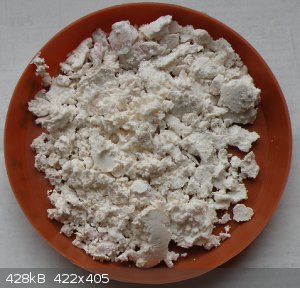| Pages:
1
2 |
kmno4
International Hazard
    
Posts: 1495
Registered: 1-6-2005
Location: Silly, stupid country
Member Is Offline
Mood: No Mood
|
|
... took another sample of salicylaldehyde.
It was much purer, giving snow-white NaHSO3 adduct and nicely looking oxime (just the aldehyde, hydroxylamine HCl and sodium acetate in water). No
free phenolic, non-aldehyde matters were detected. The oxime has funny taste: firstly it is sweet, then during 1-2 seconds it turns to sharp
pepper/paprika taste, without any aftertaste later, but nevermid 
The hydrogenation is finished now, but everything is in a flask yet.
However, few droplets of methanolic solution left on watch-glass turn wholly into crystals, after evaporation (no heating).
It means that the product is highly homogeous and this is not the oxime  It
looks good, very good.... It
looks good, very good....
But the truth will be shown after working-up and m.p. determination.
[Edited on 11-10-2021 by kmno4]
Слава Україні !
Героям слава !
|
|
|
Boffis
International Hazard
    
Posts: 1836
Registered: 1-5-2011
Member Is Offline
Mood: No Mood
|
|
@kmno4; I've been following your activities with considerable interest as I have not yet got round to trying similar experiments myself.
How did your product turn out? Do you think it is the required hydroxybenzylamine?
|
|
|
kmno4
International Hazard
    
Posts: 1495
Registered: 1-6-2005
Location: Silly, stupid country
Member Is Offline
Mood: No Mood
|
|
Hi Boffis.
(EDITED)
.... when no more H2 was consumed, everything was disconnected from my H2 generator and flask with methanolic solution (and Pd catalyst) was set
aside. Pd/alumina was then filtered off (paper filter), the solution (yellow-orange) was set for distillation.
Most of MeOH was distilled off, leaving reddish water solution.
This, when cooled, deposites some crystals (needles) but ~20 g of water was added and set for another distillation.
During this process, water was collected together with some organic impurities. Some salicylaldehyde was detected and some very stinky phenolic matter
also distilled off with water. Distillation was stopped, when about ~20 cm3 of water/organic mixture was collected and no more oily (and stinky)
droplets were formed.
It is poor man"replacement" for vacuum distillation (originally in the article). At least almost all non-basic by-products were removed in this way.
About 1-2 cm3 of organic fraction separates, slowly becoming brown in the air on prolongated storing. Some attempt was made to recover
salicylaldehyde from this mixture (as its oxime), but without any effects - no oxime separates. Most possibly, its content is low, however easily
detectable by the odor.
Clear, orange-reddish redisue, being mostly water solution of hydrochlorides, was transfered to smaller beaker and water was added to obtain ~50 cm3
of total volume. During H2O addition, the mixture becomes a little cloudy. Instead of NH3(aq), solid NaOH wad used to neutralize the solution (also
Na2CO3 can be used instead of NaOH). When pH becomes only slightly acidic (~4), the solution becomes more turbid, some light brownish sticky substance
saparates. At this point NaHCO3 was used for better pH control. At pH 5,5-6, more sticky matter colllests and the water solution becomes much less
colored. At this point it was filtered (paper), but the filtrate still depostis this sticky something when pH is decreased. So this step should
omitted and careful neutralization shoud be continued. At still lower pH, the solution becomes practically colorless, white sediment with brownish
'chunks' separates, some ammonia-like odour is present.
Some dil. H2SO4 was added, to set pH around 6-7, to remove as much as possible the sticky crap, without precipitation of the white desired amine.
Unfortunalety, is not possible, at least under given conditions to make complete separation.
The amout of the brown crap is rather small, possibly less than 0,5 g, but it considerably hinders purification.
Anyway, the white sediment was precipitated with NaHCO3 and filtered. Unfortunately, it is very "hydrophilic" and after filtration (vacuum) still
contains very lagre amout of absorebed water. From starting 10 g of aldehyde, 16 g of wet white mud was obtained. It seems it contains more than 50 %
water  . .
Additional purification is needed, but I have no time now for it 
On the picture - mentioned 16 g of wet amine (some colored chunks are also visible). BTW - it was filered today, after many days standing, it seems it
is rather air/oxygen resistant.
The powder has strong bitter taste, without any phenolic or aldehyde aftertaste. Its m.p. was not determined, at this stage it is a waste of time.

[Edited on 17-10-2021 by kmno4]
Слава Україні !
Героям слава !
|
|
|
| Pages:
1
2 |
|